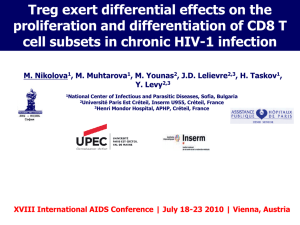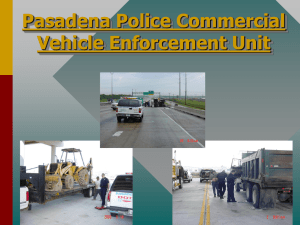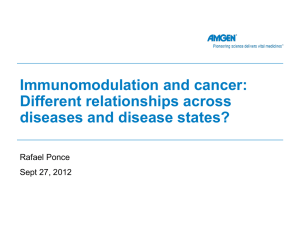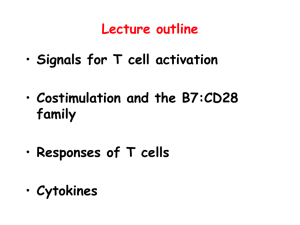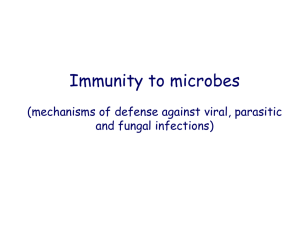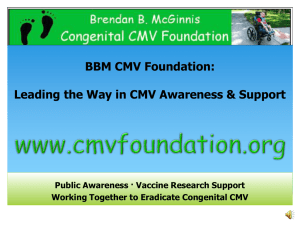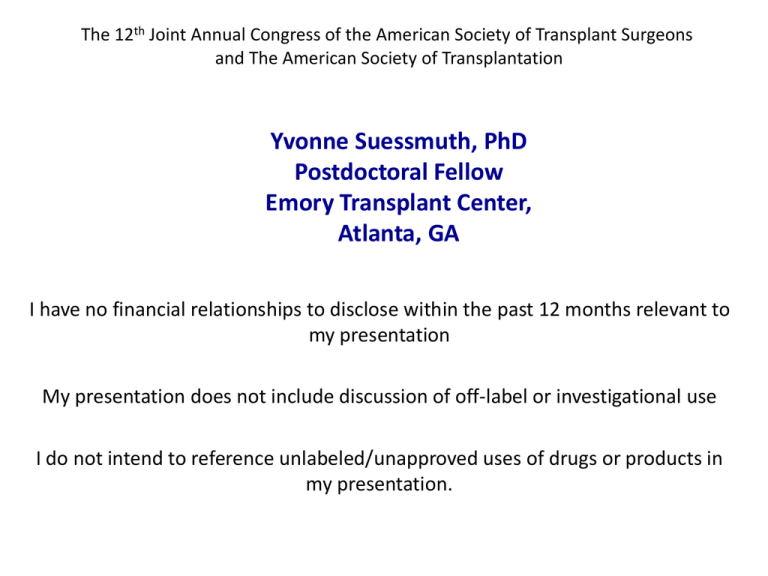
The 12th Joint Annual Congress of the American Society of Transplant Surgeons
and The American Society of Transplantation
Yvonne Suessmuth, PhD
Postdoctoral Fellow
Emory Transplant Center,
Atlanta, GA
I have no financial relationships to disclose within the past 12 months relevant to
my presentation
My presentation does not include discussion of off-label or investigational use
I do not intend to reference unlabeled/unapproved uses of drugs or products in
my presentation.
Comparison of Viral Immunity in
Stable Renal Allograft Recipients
Treated with
Belatacept or Tacrolimus
Yvonne Suessmuth PhD, PW Thompson; C
Breeden; B Johnson; R Jones; LA Stempora; J
Cheeseman; J Joseph; B Begley; S Thomas;
AD Kirk; K Newell; CP Larsen; AK Mehta
Emory Transplant Center
Emory Transplant Center
Belatacept
• Newly approved high-affinity
CTLA4Ig variant
• Blocks interaction of CD28 with
•
CD80/86
Inhibits T cell proliferation and
differentiation
Improved GFR in belatacept groups vs.
CSA
Improved metabolic control
•
• Increased incidence of EBV related
PTLD
• Very little data on impact of
belatacept on protective immunity
10
9
8.8
Bela EBV (-) [n = 91]
Bela EBV (+) [n = 810)
CsA EBV (-) [n = 57]
CsA EBV (+) [n = 399]
8
7
Patients (%)
•
X
X
6
5.49
5
4
3.3
3
1.75
2
1
1.75
0.74
0.25
0
All PTLD
0.49
0
CNS PTLD
0
0.25
0.25
Non-CNS PTLD
Larsen et al. Am J Transplant 2006; 6: 876 – 883.
In vitro treatment of PBMCs with Belatacept
does not inhibit EBV specific memory
1.5
ns
**
ns
1.0
p = 0.0139
p = 0.0087
p = 0.0060
p =0.0056
0.5
%CD8+ T cell Double Producers
% Double Producer CD8s
1.5
ns
1.0
p = 0.1404
0.5
0.0
unstimulated
No drug
unstimulated 2 mcg Bela
unstimulated 20 mcg Bela
unstimulated 200 mcg Bela
unstimulated
TS-1
0.0
unstimulated
No drug
2 mcg Bela
20 mcg Bela 200 mcg Bela
TS-1
Figure 2: Paired analysis of the unstimulated condition by each conditions
Mehta AK, et al. ATC 2011
In vitro treatment of PBMCs with Belatacept
does not inhibit EBV specific memory
1.5
ns
**
ns
1.0
p = 0.0139
p = 0.0087
p = 0.0060
p =0.0056
0.5
%CD8+ T cell Double Producers
% Double Producer CD8s
1.5
ns
1.0
p = 0.1404
0.5
0.0
unstimulated
No drug
unstimulated 2 mcg Bela
unstimulated 20 mcg Bela
unstimulated 200 mcg Bela
unstimulated
TS-1
0.0
unstimulated
No drug
2 mcg Bela
20 mcg Bela 200 mcg Bela
TS-1
Figure 2: Paired analysis of the unstimulated condition by each conditions
• Lack of data on viral specific protective immunity in
patients treated with belatacept
Mehta AK, et al. ATC 2011
Study Design and Patient populations
• Subjects were enrolled from existing immune monitoring protocols
at Emory University
• Peripheral blood samples were collected at a single timepoint
• Phenotypic and functional analysis of peripheral blood lymphocytes
were performed using rationally-designed and validated flow
cytometric panel
• 10 healthy volunteers
• 10 transplant recipients (>6mos s/p renal allograft) on stable
dose of Belatacept, MMF, and prednisone
• 10 transplant recipients (>6mos s/p renal allograft) on stable
dose of Tacrolimus, MMF, and prednisone
Subject Characteristics
Group
Treatment
Number
(n)
Median Age
(range)
Sex
(M/F)
# months
s/p txp
Seropositive
(EBV/CMV)
Healthy Controls
None
10
43.8
(29- 55)
5/5
n/a
9/5
Tacrolimus + MMF
+ Prednisone
10
49.3
(34- 66)
6/4
51.7
(6- 120)
10/7
Belatacept + MMF
+Prednisone
10
51.1
(34- 63)
4/6
92.2
(44- 128)
9/7
Tacrolimus
(>6m s/p kidney txp)
Belatacept
(>6m s/p kidney txp)
Subject Characteristics
Group
Treatment
Number
(n)
Median Age
(range)
Sex
(M/F)
# months
s/p txp
Seropositive
(EBV/CMV)
Healthy Controls
None
10
43.8
(29- 55)
5/5
n/a
9/5
Tacrolimus + MMF
+ Prednisone
10
49.3
(34- 66)
6/4
51.7
(6- 120)
10/7
Belatacept + MMF
+Prednisone
10
51.1
(34- 63)
4/6
92.2
(44- 128)
9/7
Tacrolimus
(>6m s/p kidney txp)
Belatacept
(>6m s/p kidney txp)
Methods
• PBMCs were rested 8h in 10% RPMI, then stimulated for 12h with either:
• CMV pp65 PepMix = 15-mers overlapping by 11 aa covering the length of pp65
• EBV BZLF PepMix = 15-mers overlapping by 11 aa covering the length of BZLF
• EBV Peptide pool = Peptides from several EBV proteins but restricted by HLA types
• Cells were then stained for the following markers:
FITC
PE
PerCPCy5.5
APC
PE-Cy7
Alexa
700
V450
Qdot 655
APC-Cy7
Pac Orange
CD28
CD27
IFNγ
TNFα
CD4
CD8
CD3
CD45RA
CCR7
CD14/CD20
+Live/Dead
MIP1β
CD107a
IFNγ
TNFα
IL-2
CD8
CD3
CD45RA
CCR7
CD14/CD20
+Live/Dead
MIP1β
CD154
IL-17
CCR5
CD4
CD8
CD3
CD45RA
CCR7
CD14/CD20
+Live/Dead
Methods
• PBMCs were rested 8h in 10% RPMI, then stimulated for 12h with either:
• CMV pp65 PepMix = 15-mers overlapping by 11 aa covering the length of pp65
• EBV BZLF PepMix = 15-mers overlapping by 11 aa covering the length of BZLF
• EBV Peptide pool = Peptides from several EBV proteins but restricted by HLA types
• Cells were then stained for the following markers:
FITC
PE
PerCPCy5.5
APC
PE-Cy7
Alexa
700
V450
Qdot 655
APC-Cy7
Pac Orange
CD28
CD27
IFNγ
TNFα
CD4
CD8
CD3
CD45RA
CCR7
CD14/CD20
+Live/Dead
MIP1β
CD107a
IFNγ
TNFα
IL-2
CD8
CD3
CD45RA
CCR7
CD14/CD20
+Live/Dead
MIP1β
CD154
IL-17
CCR5
CD4
CD8
CD3
CD45RA
CCR7
CD14/CD20
+Live/Dead
Gating Strategy
Lymphocytes
Live/Dead +CD14/CD20
FSC-H
SSC-A
97.3
62.2
FSC-A
Live CD3 cells
Singlets
75.5
FSC-A
CD3
Gating Strategy
Lymphocytes
Live/Dead +CD14/CD20
FSC-H
SSC-A
Live CD3 cells
Singlets
97.3
62.2
75.5
FSC-A
FSC-A
CD3
CD4 vs CD8 cells
CD4
40
55
CD8
Gating Strategy
Lymphocytes
Live CD3 cells
Live/Dead +CD14/CD20
SSC-A
FSC-H
Singlets
97.3
62.2
75.5
FSC-A
FSC-A
CD3
CD4 vs CD8 cells
11.7
32.1
CD4
CD27
40
54.8
0.0395
1.33
0.655
55
TNF
CD28
CD8
99.1
0.179
IFN
Belatacept treated patients show no difference
in TNFα/IFNγ production in CD4 cells compared
to Tacrolimus
Frequency of TNFa+/IFNg+ CD4 cells
0.3
0.2
0.1
pe
V
EB
V
C
M
pt
at
id
ed
e
0.0
ul
IFN
0.4
im
0.142
Healthy Control
Belatacept
Tacrolimus
st
99.4
8
6
4
2
un
0.229
TNF
0.259
% CD4 TNF+/IFN +
Belatacept patient
CD4 EBV stimulated
Belatacept treated patients show no difference
in TNFα/IFNγ production in CD8 cells compared
to Tacrolimus
Belatacept patient
CD8 EBV stimulated
0.0369
Frequency of TNFα+/IFNγ+ CD8 cells
0.803
TNF
12
98.6
0.628
IFN
Belatacept patient
CD8 CMV stimulated
0.0557
0.502
% CD8 TNF+/IFN +
8
4
Belatacept
Tacrolimus
Healthy Control
1.5
1.0
0.5
V
M
C
e
pe
V
EB
0.689
IFN
un
98.8
st
im
ul
pt
at
id
ed
TNF
0.0
Belatacept treated patients show no difference
in TNFα/IFNγ production in CD8 cells compared
to Tacrolimus
Belatacept patient
CD8 EBV stimulated
0.0369
Frequency of TNFα+/IFNγ+ CD8 cells
0.803
TNF
12
98.6
0.628
IFN
Belatacept patient
CD8 CMV stimulated
0.0557
0.502
% CD8 TNF+/IFN +
8
4
Belatacept
Tacrolimus
Healthy Control
1.5
1.0
0.5
V
M
C
e
pe
V
EB
0.689
IFN
un
98.8
st
im
ul
pt
at
id
ed
TNF
0.0
Belatacept patients show more TNFα/IFNγ production
in Central Memory cells but lower in Naïve CD8 cells in
response to EBV stimulation
Central Memory CD8
p= 0.028
2.0
% CD8 TNF+/IFN +
4
p= 0.054
HC EBV
Bela EBV
Tac EBV
CCR7
2
0.5
Ta
c
EB
V
V
EB
el
a
B
H
C
V
EB
c
Ta
B
el
a
EB
V
EB
V
Stimulation Groups
EB
V
0.0
0
TCM
1.5
HC EBV
Bela EBV1.0
Tac EBV
H
C
% CD8 TNF+/IFN +
6
Naive CD8
Naive
TEM TEMRA
CD45RA
Belatacept patients show more TNFα/IFNγ production
in Central Memory cells but lower in Naïve CD8 cells in
response to EBV stimulation
Central Memory CD8
p= 0.028
2.0
% CD8 TNF+/IFN +
4
p= 0.054
HC EBV
Bela EBV
Tac EBV
CCR7
2
0.5
Ta
c
EB
V
V
EB
el
a
B
H
C
V
EB
c
Ta
B
el
a
EB
V
EB
V
Stimulation Groups
EB
V
0.0
0
TCM
1.5
HC EBV
Bela EBV1.0
Tac EBV
H
C
% CD8 TNF+/IFN +
6
Naive CD8
Naive
TEM TEMRA
CD45RA
Belatacept patients show more TNFα/IFNγ production
in Central Memory cells but lower in Naïve CD8 cells in
response to EBV stimulation
Central Memory CD8
p= 0.028
2.0
% CD8 TNF+/IFN +
4
p= 0.054
HC EBV
Bela EBV
Tac EBV
CCR7
2
0.5
Ta
c
EB
V
V
EB
el
a
B
H
C
V
EB
c
Ta
B
el
a
EB
V
EB
V
Stimulation Groups
EB
V
0.0
0
TCM
1.5
HC EBV
Bela EBV1.0
Tac EBV
H
C
% CD8 TNF+/IFN +
6
Naive CD8
Naive
TEM TEMRA
CD45RA
Belatacept patients show more TNFα/IFNγ production
in Central Memory cells but lower in Naïve CD8 cells in
response to EBV stimulation
Central Memory CD8
p= 0.028
2.0
% CD8 TNF+/IFN +
4
HC EBV
Bela EBV
Tac EBV
CCR7
2
TCM
1.5
HC EBV
Bela EBV1.0
Tac EBV
0.5
0.0
V
Ta
c
Effector Memory RA CD8
2.5
2.0
HC EBV
Bela EBV
Tac EBV
1.5
1.0
0.5
0.0
% CD8 TNF+/IFN +
1.5
1.0
HC EBV
Bela EBV
Tac EBV
0.5
V
EB
Ta
c
el
a
EB
V
EB
V
HC
Ta
c
EB
V
V
EB
el
a
B
H
C
EB
V
0.0
Stimulation Groups
Naive
TEM TEMRA
CD45RA
EB
EB
el
a
B
H
C
EB
c
Ta
B
Stimulation
Groups
Effector
Memory
CD8
V
EB
V
V
V
EB
el
a
H
C
EB
V
0
% CD8 TNF+/IFN +
p= 0.054
B
% CD8 TNF+/IFN +
6
Naive CD8
In response to CMV stimulation Tacrolimus treated
patients show higher production of TNFα/IFNγ in all CD8
Memory subsets
Naive CD8
Central Memory CD8
% CD8 TNF+/IFN +
TCM
HC CMV
4
HC CMV
10
5
0
Tac CMV
CCR7
Tac CMV
2
1
V
V
V
M
M
C
c
Ta
H
el
a
C
C
C
c
el
B
V
V
M
C
C
a
M
M
M
V
C
H
C
Ta
Effector Memory RA CD8
% CD8 TNF+/IFN +
15
10
5
10
5
0
V
M
C
c
Ta
C
el
a
B
C
H
M
C
M
V
V
V
M
C
c
Ta
C
M
a
el
B
C
C
M
V
V
0
H
% CD8 TNF+/IFN +
15
20
TEM TEMRA
CD45RA
0
Effector Memory CD8
Naive
Bela CMV
Bela CMV 3
B
% CD8 TNF+/IFN +
p=0.009
5
15
Belatacept treated patients show a robust trend
towards increased CD27lo/CD28lo cells
Healthy
Belatacept
Tacrolimus
Belatacept treated patients show a robust trend
towards increased CD27lo/CD28lo cells
Healthy
Belatacept
Tacrolimus
Belatacept treated patients show a robust trend
towards increased CD27lo/CD28lo cells
Healthy
Belatacept
Tacrolimus
Increased CD27lo/CD28lo cell numbers in Belatacept
patients do not correlate with increased TNFα/IFNγ
double producing cells in this population
0.5
0.0
Frequency of TNFa/IFNg producing CD8 cells
CMV
% CD8 TNF+/IFN +
HC EBV
Bela EBV
Tac EBV
1.0
HC CMV
15
Bela CMV
Tac CMV
10
5
CD27/CD28 Subsets
D
27
-
27
+
-/ C
D
C
D
28
C
28
+/
D
C
C
D
28
-/C
C
D
D
27
27
+
-
0
D
28
+/
C
% CD8 TNF+/IFN +
Frequency of TNFa/IFNg
EBVproducing CD8 cells
CD27/CD28 Subsets
Increased CD27lo/CD28lo cell numbers in Belatacept
patients do not correlate with increased TNFα/IFNγ
double producing cells in this population
0.5
0.0
Frequency of TNFa/IFNg producing CD8 cells
CMV
% CD8 TNF+/IFN +
HC EBV
Bela EBV
Tac EBV
1.0
HC CMV
15
Bela CMV
Tac CMV
10
5
CD27/CD28 Subsets
D
27
-
27
+
-/ C
D
C
D
28
C
28
+/
D
C
C
D
28
-/C
C
D
D
27
27
+
-
0
D
28
+/
C
% CD8 TNF+/IFN +
Frequency of TNFa/IFNg
EBVproducing CD8 cells
CD27/CD28 Subsets
Increased CD27lo/CD28lo cell numbers in Belatacept
patients do not correlate with increased TNFα/IFNγ
double producing cells in this population
0.5
0.0
Frequency of TNFa/IFNg producing CD8 cells
CMV
% CD8 TNF+/IFN +
HC EBV
Bela EBV
Tac EBV
1.0
HC CMV
15
Bela CMV
Tac CMV
10
5
CD27/CD28 Subsets
D
27
-
27
+
-/ C
D
C
D
28
C
28
+/
D
C
C
D
28
-/C
C
D
D
27
27
+
-
0
D
28
+/
C
% CD8 TNF+/IFN +
Frequency of TNFa/IFNg
EBVproducing CD8 cells
CD27/CD28 Subsets
Conclusions
• Belatacept treatment does not appear to significantly impact
virus-specific immune function as compared to Tacrolimus
treatment.
• Differences in TNFα/IFNγ production are possibly due to the
difference in cohorts but need further investigation
• Differences observed between healthy controls and treated
patients in memory subsets suggest that immunosuppressive
agents influence how viral-specific memory is maintained
• Increased numbers of late differentiated cells (CD27lo/CD28lo) in
Belatacept patients do not coincide with significantly decreased
viral- specific immunity in these patients.
Future Plans
• Enroll further 10 early post transplant Belatacept
and 10 late post transplant Tacrolimus treated
patients to ensure better comparison between the
groups.
• Monitor patients longitudinally in the CTOT10 Trial
comparing long-term treatment with Belatacept to
Tacrolimus
Acknowledgments
Special Thanks To:
• Christian P Larsen
• Aneesh K Mehta
• Allan D Kirk
• Kenneth Newell
•
•
•
•
•
Peter Thompson
Linda Stempora
Cindy Breeden
Brandi Johnson
He Xu
ETC Biorepository
• Rachelle Jones
• Stephanie Monday
• Kendra Bryant
• Jennifer Cheeseman
ETC Clinical Research Coordinators
• Elizabeth Begley
• Shine Thomas
• Elizabeth Ferry
The Patients!
Grant support: A portion of this work was performed as part of the Clinical Trials in Organ
Transplantation, supported by the National Institute of Allergy and Infectious Diseases.

